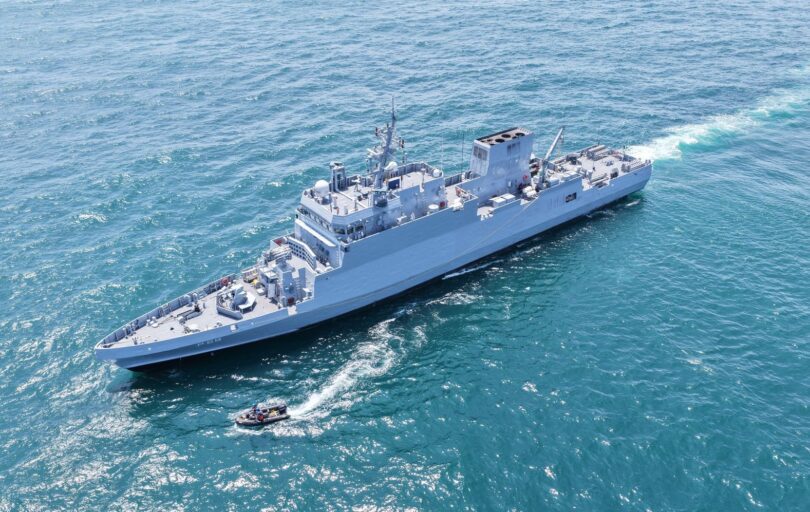The Indian Navy commissioned INS Androth, its second Anti-Submarine Warfare Shallow Water Craft (ASW-SWC), on 06 October 2025 in a ceremonial event held at the Naval Dockyard, Visakhapatnam. The ceremony was presided over by Vice Admiral Rajesh Pendharkar, Flag Officer Commanding-in-Chief, Eastern Naval Command, in the presence of senior naval officers, representatives of M/s Garden Reach Shipbuilders & Engineers (GRSE), Kolkata, and distinguished civilian dignitaries.
The ship has been named after Androth, the northernmost island of the Lakshadweep group, known for its historical and strategic maritime significance.
Production of this second ASW-SWC in India with over 80% indigenous content, underscores Indian Navy’s sustained efforts in constantly enhancing homegrown solutions and innovative technologies. 77 metres in length and displacing about 1,500 tonnes, INS Androth is specially designed to undertake anti-submarine operations in coastal and shallow waters. This state-of-the-art submarine hunter, is fitted with advanced weapons, sensors, and communication systems, enabling it to detect, track and neutralise sub-surface threats with precision. It can sustain prolonged operations in shallow waters and is equipped with technologically advanced machinery and control systems. Powered by three waterjet propulsion systems driven by marine diesel engines, it is extremely agile and manoeuvrable. Its capabilities extend to maritime surveillance, search and rescue, coastal defence missions, and low intensity maritime operations making it a versatile platform for littoral operations.
This ship will add a significant punch to Indian Navy’s anti-submarine warfare capabilities, particularly in countering threats posed by adversaries in the littorals.
Considering that India was ruled and super-exploited for over two centuries by a tiny country with a lineage of very crafty rulers but one with a large navy, following Independence, its founding political leaders and administrators failed to realise the country’s size, by way of its very long land border and coastline as well as the prevailing threats by some neighbour nations. And on matters maritime, there was near total “sea-blindness” till the third India-Pakistan war in December 1971, when the Indian Navy was used for the first time. It took much longer for New Delhi to realise that only 2280 kms away is the Indian Ocean, a vast body of water that extends far south of the Indian mainland, encompassing large portions of the Southern Hemisphere.
New Delhi also never remembered that Bharat historically had a very rich and ancient maritime legacy, with its seafaring activities dating back to the Harappan Civilisation around 2,400 BCE and maritime trade which also resulted in the spread of Indian culture, religion, and ideas spread across many continents.
India's coastline length was recently updated from the previously accepted 7,516.6 km to 11,098.81 km in 2023-24, reflecting a more detailed measurement methodology by the Survey of India that includes numerous offshore islands. This revised length incorporates the peripheral coastlines of 1,298 offshore islands and islets that were not previously measured in detail.
India has 14 major ports including the recently notified Galathea Bay Port in the Andaman & Nicobar Islands and over 200 non-major (minor and intermediate) ports, with the major ports being centrally administered and non-major ports managed by state governments or private entities. The major ports are designed to handle large-scale maritime operations and new infrastructure projects aim to develop even deeper port capabilities. Major ports are under the direct control of the Ministry of Ports, Shipping and Waterways and are designed with extensive infrastructure to handle significant cargo and ship traffic. Non-major ports managed by individual state maritime boards play a crucial role in local economies and facilitate trade along India's coastline. While there are over 200 such ports, only a fraction of them are active for cargo handling; the others are primarily used by fishing vessels and ferries. There is a continuous effort to expand deepwater port development and deepen port facilities. Projects like the Sagarmala Project aim to develop new mega ports and improve existing infrastructure to enhance India's maritime capabilities.
With such a lengthy and extended coastline, India faces a complex array of threats, including military threats from two inimical and troublesome neighbours, China and Pakistan and a range of non-traditional threats. The non-traditional maritime threats include piracy, maritime terrorism, smuggling (of drugs, arms, and wildlife), illegal fishing, and environmental degradation due to climate change. Other emerging threats involve cyber-attacks, unauthorized surveillance and the destruction of underwater infrastructure like communication cables. These challenges threaten India's economic stability, trade routes, and coastal populations by disrupting sea lanes and exploiting vulnerable sectors.
China's growing military footprint and its "String of Pearls" strategy—developing ports and strategic infrastructure in countries around the Indian Ocean, including Sri Lanka and Pakistan—pose a significant long-term challenge to India's maritime dominance. China's navy (People's Liberation Army Navy-PLAN) is the world's largest by number of ships and is rapidly expanding its blue-water capabilities. There are widespread reports that Chinese "survey" ships and other vessels frequently operate in the Indian Ocean Region, including near India's territorial waters, raising concerns in India about potential military espionage. In July 2025, a French maritime intelligence firm, Unseenlabs, revealed that a Chinese research vessel had operated covertly in the Bay of Bengal for several days with its Automatic Identification System (AIS) turned off. The firm's satellite tracking detected a radio frequency signature, suggesting the vessel was operating with strategic intent. Analysis of the vessel's movements indicated it was likely engaged in seafloor mapping, acoustic surveys, and identifying submarine transit corridors. While officially research-oriented, this data is invaluable for anti-submarine warfare and broader military intelligence.
Chinese vessels have been spotted near Indian waters, particularly before Indian missile tests. For instance, in August 2024, a vessel appeared near an Indian naval submarine firing zone, and previous instances have occurred before Agni-5 missile tests. In addition to survey vessels, China has deployed submarines in the Indian Ocean. In 2014, a Chinese submarine entered the region, signalling a broader strategy of increasing naval presence.
The Indian Navy and Coast Guard continuously monitor Chinese vessels in the Indian Ocean. India has raised diplomatic concerns with neighboring countries, such as Sri Lanka and the Maldives, over allowing Chinese vessels to dock. Indian officials view China's increased maritime presence as part of a larger strategic effort to project power in the Indian Ocean, secure its sea lanes, and counter India's regional influence. China is also building up its presence in regional ports, including Gwadar in Pakistan and Hambantota in Sri Lanka, as part of its "String of Pearls" strategy.
To bolster its defenses, India is scaling up its maritime surveillance infrastructure, including coastal radar chains and seabed surveillance networks. It is also deepening intelligence-sharing partnerships with allies like the US, Japan, and Australia.
While with the US, India’s relations have become very strained after US President’s anger and madness following India’s very effective and lethal Operation Sindoor against Pakistan, Indian and U.S. navies conducted the naval exercise Malabar 2025 in the Western Pacific, and a separate exercise with the guided-missile destroyer INS Imphal and U.S. destroyer USS Gridley in the Arabian Sea, in late September 2025. Additionally, the navies participated in the multi-nation Sea Dragon 2025 exercise, hosted by the U.S. in the Pacific.
For India’s major requirement of underwater defence, the Indian Navy currently operates 19 submarines, which include 16 conventional submarines and three nuclear-powered submarines (two ballistic missile submarines and a leased nuclear attack submarine). The fleet is aging, with many conventional submarines nearing the end of their service life, leading to concerns about the Navy's underwater prowess and plans to build new submarines, including indigenous nuclear attack submarines, are underway. India’s long-term plan is to have 24 submarines.
China has around 60 to 70 submarines, with the most recent data in late 2024 and early 2025 indicating a fleet size in the low 60s or more, encompassing roughly 12 nuclear-powered and 48-50 conventional diesel -electric submarines. PLAN is also expanding its nuclear submarine capabilities, with sources suggesting that the overall fleet could reach 65-80 submarines by the mid-2020s.
PLAN is a growing presence in both the deep and shallow waters of the Indian Ocean Region. While Beijing maintains that its deployments are for anti-piracy and research, its expanding submarine fleet and intelligence-gathering operations pose a strategic concern for India across both coastal and deep-sea environments.
Pakistan, driven by its compulsive hate and enmity against India, has been upgrading its navy with help from allies like China and Türkiye. It is acquiring advanced platforms, including submarines and frigates, to enhance its anti-access/area-denial (A2/AD) capabilities and narrow the capability gap with India. China's influence in the ports of Karachi and Gwadar is also a concern for India.
The author a strategic affairs analyst and former spokesperson, Defence Ministry and Indian Army, can be contacted at wordsword02@gmail.com, https://www.linkedin.com/in/anil-bhat-70b94766/ and @ColAnilBhat8252
More on navy related topics:
UK Carrier Strike Group strengthens partnership with India: https://www.thestrategicperspective.org/uk-carrier-strike-group-strengthens-partnership-with-india/
Paramilitary forces in India are distinct from central police forces: https://www.thestrategicperspective.org/paramilitary-forces-in-india-are-distinct-from-central-police-forces/
100th & 101st Indian built warships adding to India’s military self-reliance: https://www.thestrategicperspective.org/100th-and-101st-indian-built-warships-adding-to-indias-military-self-reliance/
MoD clears big arms deals, including BrahMos, armed drones, worth Rs 67,000cr: https://www.thestrategicperspective.org/mod-clears-big-arms-deals-including-brahmos-armed-drones-worth-67000cr/
India’s Unprecedented Retribution Against A ‘Rogue State’: The Battle Against Terror Should Not Go Unfinished: https://www.thestrategicperspective.org/indias-unprecedented-retribution-against-a-rogue-state/
China’s 2049 plan a big challenge before the world: https://www.thestrategicperspective.org/chinas-2049-plan-a-big-challenge-before-the-world/











